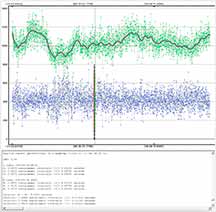

This event is of only moderate rank, and odds on the centerline are 65%. I'd plan to be on the centerline north of Moss Landing if solo, and if I'm with Kirk, then we'd straddle the centerline with enough spacing that one of us was highly likely to get it. Clouds are iffy. It's in the Milky Way of Monoceros, Alt=59, Az=153 in the SSE. Predicted duration is only 0.5s, so you can't afford to integrate too much if you want enough points in the occultation to satisfy the FP test.
 |
 |
I propose setting Kirk at the park-and-ride at Salinas Rd turn off from Hwy 1, and I'd continue down Hilltop Rd to Jensen road, turn right, and find a spot along the ag fields at the bend, to set up south of the centerline. Karl is off path and did not attempt from home. Also, still does not have camcorder remote for controlling the camcorder.
Results are reviewed and accepted, published on the IOTA website. Here's the skyplane solution
I set up at the curve in Jensen Rd, just before the first home, on the south side where an ag access comes in. Lots of clouds in the sky, but non seemed to cover the target or none that had enough depth to be clearly there as you looked at the sky. The set up went well, got on target with plenty of time, after setting up Kirk at the park-and-ride at Hwy 1/Salinas Rd a couple of miles further north. However, when it got close and time to connect up the camcorder, I discovered that all my off-loading of prior data from Callisto and others, and at the end of that I closed the flip-out screen but forgot to turn off the camcorder! And the battery was drained. So, I got out my PowerShot and propped my hand against the edge of the RAV4 door opening, and took video which I believe will be an easy reduction, with manual time stamps. I saw a clear ~0.3 or 0.4 second event a couple of seconds earlier than the nominal prediction for Cabrillo College.
It turns out that there was higher cloud density going over the target area during the event, moving slowly enough that it affected the quality of referenc'ing to remove. Still, using the nearby star to the target as a reference was far superior to not using a reference at all. Also troublesome was that I did not have time to switch my camera to macromode and so the focus of the PowerShot camera was poor. I then needed a large 14px radius for the fixed apertures. The PowerShot video is at PAL rate, just like my Watec/VTI combo, and the manual time stamp entry did not show creeping time stamp differences. I chose two time stamps just 7 sec apart, on either side of the occultation. The D and R were still not as clear as optimum, with the cloud issue. However, Kirk's data from just a ~1.5 miles north of my station was quite solid despite slow moving cloud light opacity, and my timings are in good agreement, within errors of Kirk's timings. I was closer to the expected centerline and did have a very slightly longer occultation. It satisfied the FP test beyond the 5-sigma level.
I was 25 ft south of Jensen Rd on the Ag field dirt access, at the southward bend in Jensen Rd.
magDrop report: percentDrop: 70.9 magDrop: 1.341 +/- 0.371 (0.95 ci)
DNR: 2.69
D time: [06:25:19.0253]
D: 0.6800 containment intervals: {+/- 0.0269} seconds
D: 0.9500 containment intervals: {+/- 0.0764} seconds
D: 0.9973 containment intervals: {+/- 0.2177} seconds
R time: [06:25:19.7109]
R: 0.6800 containment intervals: {+/- 0.0269} seconds
R: 0.9500 containment intervals: {+/- 0.0764} seconds
R: 0.9973 containment intervals: {+/- 0.2177} seconds
Duration (R - D): 0.6856 seconds
Duration: 0.6800 containment intervals: {+/- 0.0403} seconds
Duration: 0.9500 containment intervals: {+/- 0.1014} seconds
Duration: 0.9973 containment intervals: {+/- 0.2447} seconds
 |
Kirk setting up at the park/ride bus stop |
 |
I'm out in the fields off Jensen Rd |
Set up at the park/and/ride at Hwy 1 and Salinas Rd, on Hilltop Rd, at the bus stop bench. Got a clear 0.65 sec event on 1994 VA, earlier than predicted, and longer than predicted max. The curves look like a roller coaster from the passing clouds. I normalized on the tracking star, although the event is obvious without normalizing.
 |
 |
 |
 |